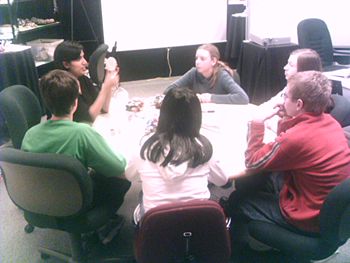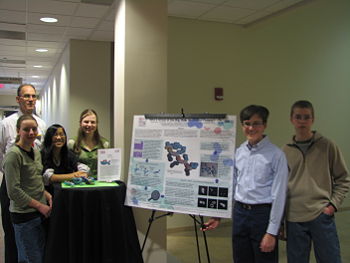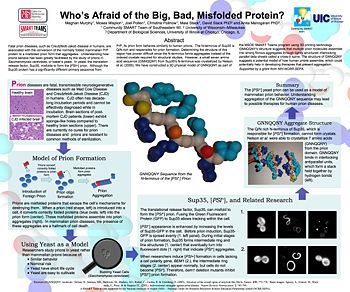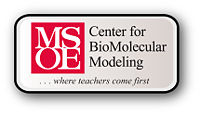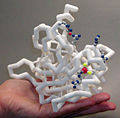Group:SMART:A Physical Model of the Structure of GNNQQNY from Yeast Prion Sup35
From Proteopedia
Contents |
A SMART Team Molecular Story --- from the 2009 Community SMART Team of Southeast Wisconsin
- Students -- Moses Misplon, Meghan Murphy, Joel Pollen, Christine Pollnow, Maia Stack
- Advisor: David Stack, Ph.D., University of Wisconsin–Milwaukee
- Mentor: Anita Manogaran, Ph.D., University of Illinois at Chicago
|
Abstract for Our Project
Fatal prion diseases, such as Creutzfeldt-Jakob disease in humans, are associated with the conversion of the normally folded mammalian PrP protein to a misfolded prion form that aggregates. Understanding how prions behave has been greatly facilitated by the study of prions in Saccharomyces cerevisiae, or baker’s yeast. In yeast, the translation release factor, Sup35, misfolds to form the [PSI+] prion. Although the Sup35 protein has a significantly different primary sequence from PrP, its prion form behaves similarly to human prions. The N-terminus of Sup35 is Q/N-rich and responsible for prion formation. Determining the structure of this region has proven difficult since the N-terminus forms aggregates instead of the ordered crystals required for structural studies. However, a small seven amino acid sequence (GNNQQNY) from Sup35's N-terminus was crystallized by Nelson et al. (2005). We have constructed a 3D physical model of GNNQQNY as part of the MSOE SMART Teams program using 3D printing technology. GNNQQNY's structure suggests that multiple prion molecules assemble into strong fibrous aggregates through tightly structured interlocking parallel beta sheets called a cross-β spine. The structure of GNNQQNY suggests a potential model of how human prions assemble, which could potentially help in developing therapies that prevent aggregation. Supported by a grant from NIH-NCRR-SEPA.
Creating the Physical Model of GNNQQNY
|
Virtually any image of a protein that can be created in the computer environment of RP-RasMol, can be converted into a physical model of the protein using rapid prototyping technology. To design our model of the structure of the GNNQQNY from yeast prion Sup35, we used the atomic coordinates for this structure as reported in the pdb file 1yjp, from the Howard Hughes Medical Institute, UCLA-DOE Institute for Genomics and Proteomics.
Beginning with the raw 1yjp pdb file, the format was set to ball and stick and the spacefill set to 225. The water molecules were deleted and half the model was colored cyan to represent the wet interface. The dry interface was colored blue and the backbone was colored white. The oxygen molecules were colored red for Asn2 and Asn3, orange for Gln4 and Gln5 and yellow for Asn6 and Tyr7.
A ply file describing this final structure was exported from RP-RasMol and sent to the MSOE Center for BioMolecular Modeling, where it was constructed from plaster powder, using a color ZCorp 3D printer.
References
1) Nelson, R., Sawaya, MR., Balbirnie, M., Madsen, AO., Riekel, C., Grothe, R. & Eisenberg, D. (2005). Structure of the cross ß-spine of amyloid-like fibrils. Nature. 435, 773-778.
2) Shkundina, I.S. & Ter-Avanesyan, M.D. (2007). Prions. Biochemistry (Moscow). 72:13, 1519-1536.
Our Poster and Presentations
Presentations of our project, poster, and physical models:
-- Medical College of Wisconsin SMART Team Poster Session, March 6, 2009
-- American Society for Biochemistry and Molecular Biology Undergraduate Research Poster Competition, April 18, 2009
-- University of Wisconsin Milwaukee Undergraduate Research Symposium, April 24, 2009
MSOE Center for BioMolecular Modeling and SMART Teams
SMART Teams (Students Modeling A Research Topic) is a science outreach program developed by the MSOE Center for BioMolecular Modeling. In this program, teams of high school students work with a local resarch lab to design and build a physical model of a protein that is being investigated by the lab. The goal of the SMART Team program is to introduce students to the real world of science --- as it exists in a local research lab. The development of this program was supported by grants from the NIH-NCRR SEPA program (Science Education Partnership Award) and an HHMI Precollege Science Education Award. For more information about this program, visit the CBM web site at www.rpc.msoe.edu/cbm .

